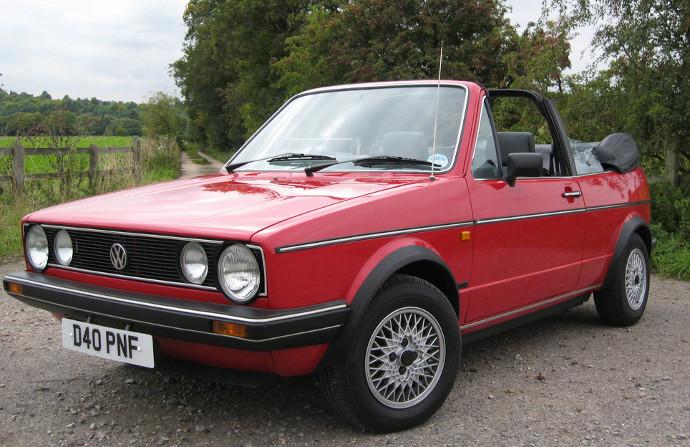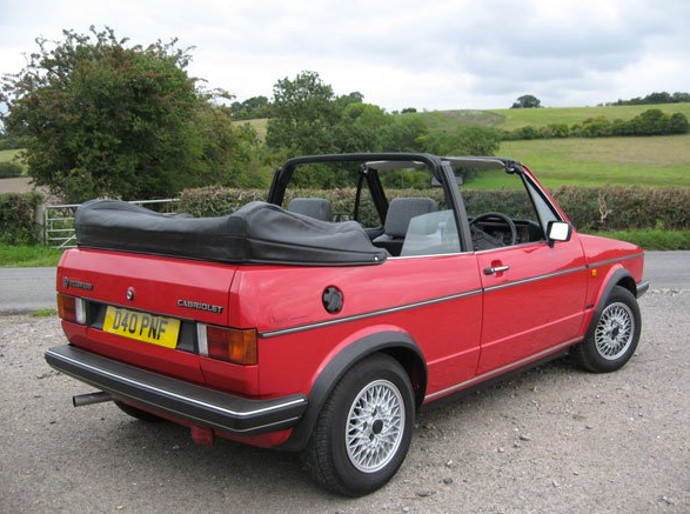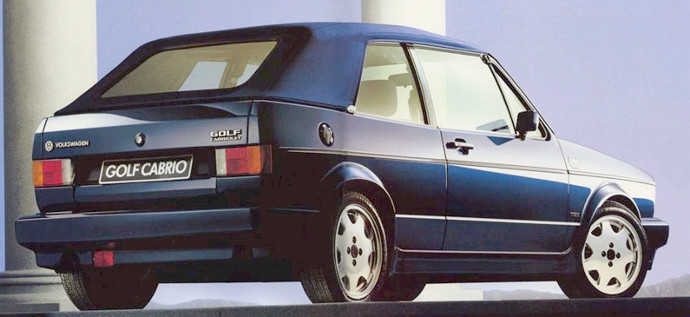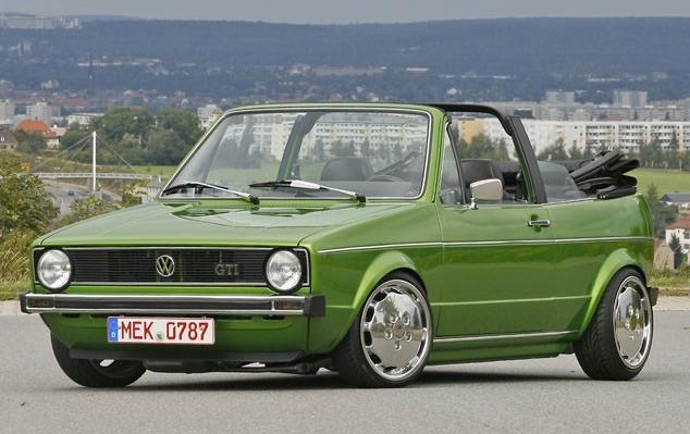The sun’s shining and the sap’s rising so it must be time to go topless. And what better car to do it in than an early convertible Golf? For the ultimate wind through your hair fix, here’s our VW Golf Mk1 Cabriolet buying guide, Hopefully it’ll help you pick up a classic open top gem.
Wind through the hair retro Dub motoring doesn’t get any better than in an roofless Golf Mk1. And the beauty is, if you love the angular looks of the original Golf, you can get a relatively new car because production of the convertible continued long after the original hatch finished. Moreover, completely illogically, prices for the convertible are generally much lower than the tin top version, so there’s the opporunity of picking up a bit of a bargain at the same time!
Model range
Making its debut at the Geneva Motor Show in 1979, the topless Golf was offered in most countries as the GLi with a 1588cc GTi engine and stiffer suspension, alongside the GLS which had the 70bhp 1457cc unit. The GLi convertible got the 1.8 GTi engine in 1982 and the smaller petrol lump was replaced by the 1595cc carburettor unit in 1983. The dash was refashioned in 1981 to include a lockable glovebox and centre console, while better sports seats became standard from 1983. By 1985, the GTi nomenclature was adopted, and the 1.6 GL was now available with auto and 4+E gearbox options.

Of course the Mk2 replaced the Mk1 in 1984, but the topless version kept the beautifully retro lines of the classic original Golf for much longer. However, in 1988 there was an attempt at modernisation when moulded bumpers, integrated front and rear spoilers and sill and wheelarch extensions were added. The Clipper appeared at this time with 1.8 carburettor power, replacing the GL.

Spec levels were improved in 1990 and for the first time a hydraulically operated power hood became an option on GTI models. Special colour coded ‘All White’ and ‘All Black’ models proved particularly popular. The all blue CC model with its blue hood and blue trim was also a hit – so much so that VW introduced its own Quartet range which meant that you could colour mix and match to your heart’s content with 64 different permutations.

The Sportline from 1991 with its Recaro pews particularly appealed to younger buyers, as did the posh Rivage with its Classic Blue paint, Mauritius Blue cloth interior and Indigo Blue hood. The Rivage Leather, you guessed it, featured beige leather seats and was available in Classic Green Pearl metallic. The last ‘classic’ looking convertible was replaced by the bigger, Golf 3 Cab in 1993.
Behind the wheel
Despite weighing roughly 100kg more than its tin-top equivalent, both the 1.6- and 1.8-litre Mk1s are swift enough, though, the extra weight impacts on handling, so expect a bit more body roll if you try to take a tight corner too aggressively. Expect some scuttle shake too, but with the added rigidity of that hefty rollover bar, it’s not as bad as in the Beetle Cabriolet.
Under the bonnet
Engine-wise, the Mk1 cabriolets are exactly the same as the Mk1 hatchbacks so you’re looking for the same issues, basically, as well as proof that it’s been regularly serviced. Oil and filter changes should have been carried out every 5000 miles and a cambelt change every 40,000 miles or four years (which ever comes first). All being well when you come to start the engine you won’t see blue haze coming out of the tailpipe either – a sure-fire sign that the valve guide seals will need replacing. These cars should only continue to smoke in exceptional cases as this implies the bores have worn.

It may be that a previous owner has decided to swap the problematic Pierburg carb for a more reliable Weber version– or you could carry out a rebuild yourself with this kit. On the fuel-injected cabriolets you’ll need to check for cold start problems and for an even idle. In the case of misfires, check for faulty plugs and HT leads. While out on test it’s also a good idea to rev the engine to ensure there aren’t any flat spots and that there’s a smooth idle. Gearboxes too are usually robust but you may need to sort the complex linkages. Watch out too for crunching synchromesh in second.
Running gear
Begin by checking the suspension springs – the extra weight means that a cabriolet’s rear set in particular are more likely to snap than those on the hatchback. The same goes for tyre wear at the front, so check your tread depths – it’s a point to haggle over if nothing else. Check the steering rack mounting point is properly secured in place. If it has broken away from the body you’ll be left with a huge amount of left/right play. Other than that, check the oil-filled dampers for leaks and also that the bushes haven’t deteriorated – seen as these cabriolets aren’t exactly known for their handling prowess you’ll really want suspension to be hitting its full potential.

Bodywork
The hatchbacks and cabriolets are near enough identical when it comes to their mechanicals, but the Karmann-designed bodies differ vastly from the tin-tops. With no roof, a number of extra body strengthening are needed to make up for the loss in rigidity – namely an extra cross member, deeper sills and a rollover hoop. All of which results in extra weight.
With Mk1 cabriolets start by inspecting the sills; if there are holes, then it’s usually a lot worse in a lot of other places too. You can replace them, but it’s worth noting that rear panels are unavailable – another reason for trying to find a good shell. Also, on the post-‘87 models (including the special edition Sportline and Rivage) the sills are covered by side skirts and so any rot here will be hidden. Other places you’ll need to check are those that differ from the hatchback. This includes the beam that’s fitted between the rear turrets (ideally, there should be no corrosion here) and the inner wings – these come with extra body strengthening. The underside differs slightly too: the fuel tank and the spare wheel for example.
Hood matters
The hood is a thing of engineering beauty, but you need to check it carefully for fit and condition – you’re looking for any cracks, rips, discolourations and missing or worn rubbers, which could result in leaks. If inside there are damp carpets this is definitely a bad sign. But if when you lift these and find heavily-corroded floorpans, the wisest move may simply be to walk away.

The condition of the rear window frame is equally important. If it hasn’t already been replaced it will most likely have corroded by now – yellow-ish stains on the parcel shelf are a tell-tale sign. Ideally, a rotten frame should be replaced before a new roof skin is fitted, as it’s a difficult job to do properly retrospectively. If the hood appears to bow or lift in the middle then it’s usually the side tension cables that have snapped, but it’s an easy fix. You should also check for lumpiness. This means that the horse hair pad between the outer skin and the frame has deteriorated. It’s there as insulation and soundproofing and is unavailable. However, there are specialists who can repair it.
Post-1990 GTI cabriolets will have an electrically-assisted hood. It also came as standard on the Rivage GTI so check it works okay. The pumps are generally very reliable, but they do fail from time to time. When they do they can cost up to £1200 new through Volkswagen. Thankfully, secondhand reconditioned units are also available. The hydraulic rams can also leak, but this is something that’s down to wear and tear rather than a specific fault. Don’t forget to check the pump reservoir for leaks either.
Inside job
There shouldn’t be too many nightmares inside a Mk1 Cabriolet as VW cabins from this era are generally sparse but very hard-wearing. But even if you do come across a dog-eared example (and still fancy its restoration prospects) pretty much all the trim you’ll need is readily available.

Don’t forget to make sure everything works – we’re talking about items such as the central locking and immobiliser and the electric windows (if fitted) – broken wiring in the driver’s side door could be the reason behind these not working.
What to pay
We’ve been leaving the best bit until last, because we still uphold that the early Golf Cabriolet is undervalued. Moreover, because often they will have been spared a severe thrashing from the modding stick, you’ll have more original, unmolested examples to choose from.
At the bargain basement end of the market, between £1000 and £1500 will get you something with an MoT that needs fettling. That might mean a new hood, refreshed suspension and a few other bits – but because Golf Mk1 parts are readily available here, you can do it all yourself for not much money.
As little as £2000-£2500 will be all that’s needed for a rather nice late-eighties/early-nineties Clipper or GTI Cabriolet, which shouldn’t need too much doing to it. The special editions will cost a little more and you might pay a premium for something like a Rivage Leather.
Happy hunting.
Ian
Incidentally, if you missed our Mk1 Golf hatch buying guide, you can see it here.
The opinions expressed here are the personal opinions of the author and do not necessarily represent the views and opinions of VW Heritage.


Good morning
I´m Nuno from Portugal
I want to buy one GOLF CABRIO GTI 1.8 WHITE LINE, 1992.
The car is almost new, with 80.000 kms, allways in garage.
Can you say how much is its value?
Thank you very much.
Looking forward to hear from you
Best regards
Nuno
Good Morning Ian,
I am looking into purchasing a used 1982 VW Rabbit Convertible. The owner is asking $1500 (USD), which i know is high. He is letting me test drive the car this weekend, but whats a good base price to start negotiating? i dont want to offend the guy by low balling him off the bat, but i dont want to get screwed over for being a nice guy. Please shoot me an email if you have time, i’d love to talk to you more in depth.
Thank you,
Dylan
Hi Dylan
Hard to say without seeing it, obviously. It’s all about body condition – so if it’s straight, no dents and no rust – and the hood’s good, then 1500 dollars doesn’t sound expensive. Quiz the seller about when the timing belt was last changed and, assuming it hasn’t been done for a while, then possibly use this as a negotiating tool to knock a few ‘bucks’ off. But honestly, if it’s all there, and it’s original, and there’s evidence that it’s been looked after (garage receipts) then why not go for it.
Cheers
Ian
Hi Ian, what’s the automatic gearboxes like on the mk1
I can’t find VW Golf Mk1 Cabrio, wish I could find one, can anyone help with search? Thanks in advance
I have a 1979 mk I with 100k km on the clock. It was the first golf convertible in Portugal. Could you be interested?
Hi Ian,
We just purchased a 1993 cabrio which is undergoing a paint job but I need a few parts and I am finding it really hard to find vendors for this specific model in the US. Any advice on where I can find replacement parts for this model?
All advice is appreciated.
Best
Sebastian
Hi there,
Just wondering do the rear seats fold down? and can you put a long load through to the front
Yes
Hi I’ve been looking at a Karmann clipper 1989. The owner is saying it’s a mark one but I’m sure it’s a Mk2? I’m confused? Can anyone help please.
VW never made a Mk2 Golf Cabriolet – they just facelifted the Mk1 with bigger bumpers and a different grille.
My Mk1 golf CC Gti cabrio 1986 ,what does the CC Stand for,? Thank you,Gerry N,
Hi Gerry, it stands for Christmas Cabriolet.
More details can be found here.
http://museum.cabby-info.com/christmascabrio.htm
Hello
I have a MK 1 Golf rally car and looking for options for a power steering quick rack possibly about 2 tunes lock to lock
Thanks